Our Products

Gypsum
Gypsum is a soft sulfate mineral composed of calcium sulfate dihydrate, with the chemical formula CaSO4·2H2O. It is widely mined and is used as a fertilizer and as the main constituent in many forms of plaster, blackboard/sidewalk chalk, and drywall. A massive fine-grained white or lightly tinted variety of gypsum, called alabaster, has been used for sculpture by many cultures including Ancient Egypt, Mesopotamia, Ancient Rome, the Byzantine Empire, and the Nottingham alabasters of Medieval England. Gypsum also crystallizes as translucent crystals of selenite. It forms as an evaporite mineral and as a hydration product of anhydrite.
The Mohs scale of mineral hardness defines gypsum as hardness value 2 based on scratch hardness comparison.

Plasterboard
Drywall (also known as plasterboard, wallboard, sheet rock, gypsum board, buster board, custard board, or gypsum panel) is a panel made of calcium sulfate dihydrate (gypsum), with or without additives, typically extruded between thick sheets of facer and backer paper, used in the construction of interior walls and ceilings.
The plaster is mixed with fiber (typically paper, glass wool, or a combination of these materials), plasticizer, foaming agent, and various additives that can reduce mildew, flammability, and water absorption.
In the mid-20th century, drywall construction became prevalent in North America as a time- and labor-saving alternative to traditional lath and plaster

Mineral Wool
Mineral wool is any fibrous material formed by spinning or drawing molten mineral or rock materials such as slag and ceramics.
Applications of mineral wool include thermal insulation (as both structural insulation and pipe insulation, though it is not as fire-resistant as high-temperature insulation wool), filtration, soundproofing, and hydroponic growth medium.

Portland Cement
Portland cement is a complex product obtained from unprocessed common natural materials: limestone and clay. Consequently, the characteristics of Portland cement clinker may vary from one cement plant to another. To limit the variations of the technological properties of Portland cement, acceptance standards have been developed, but presently these standards are not satisfactory for the whole concrete market. Low w/c cements are increasingly used; these concretes are made using large dosage of superplasticizers to disperse cement particles. It is therefore urgent for the cement industry to produce a clinker that will facilitate the production of the low w/c concretes that are more sustainable than normal-strength concretes. The production of the old Type I/II clinker must continue to satisfy the needs of this very profitable market, because now that we know how to increase concrete compressive strength, it is very important that we focus on how to improve the rheology of these concretes in order to transform concrete into a quasi-liquid material that can be poured without any problem.

White Portland Cement
White Portland cement has essentially the same properties as gray cement, except for color. It is readily available throughout North America.
The color of white cement is determined by its raw materials and the manufacturing process. Metal oxides, primarily iron and manganese, influence the whiteness and undertone of the material.
After adding pigments, white cements produce clean, bright colors, especially for light pastels. Many different colors of concrete can be created, and just like with paint, two or more pigments can be combined to achieve a wide range of colors. An even greater variety of decorative looks can be achieved by using colored aggregates and varying the surface finish treatment or texture.

Cristobalite
Cristobalite is a mineral polymorph of silica that is formed at very high temperatures. It is used in dentistry as a component of alginate impression materials as well as for making models of teeth.
It has the same chemical formula as quartz, SiO2, but a distinct crystal structure. Both quartz and cristobalite are polymorphs with all the members of the quartz group, which also include coesite, tridymite and stishovite. Cristobalite occurs as white octahedra or spherulites in acidic volcanic rocks and in converted diatomaceous deposits in the Monterey Formation of the US state of California and similar areas. Cristobalite is stable only above 1470 °C, but can crystallize and persist metastable at lower temperatures. It is named after Cerro San Cristóbal in Pachuca Municipality, Hidalgo, Mexico.
